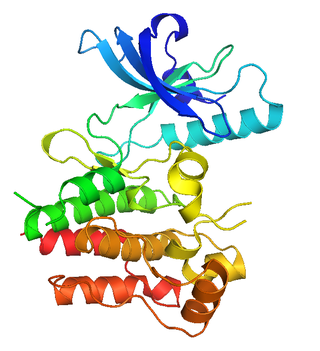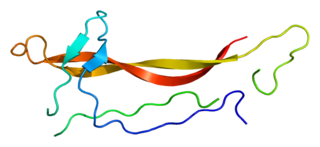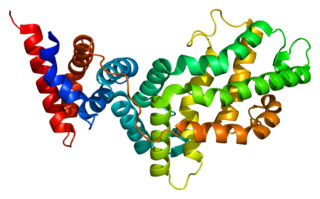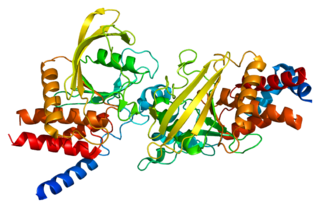Angiopoietin-1 receptor also known as CD202B (cluster of differentiation 202B) is a protein that in humans is encoded by the TEK gene. [5] [6] Also known as TIE2, it is an angiopoietin receptor.
Angiopoietin-1 receptor also known as CD202B (cluster of differentiation 202B) is a protein that in humans is encoded by the TEK gene. [5] [6] Also known as TIE2, it is an angiopoietin receptor.
The TEK receptor tyrosine kinase is expressed almost exclusively in endothelial cells in mice, rats, and humans. (TEK is closely related to the TIE receptor tyrosine kinase.) [7]
This receptor possesses a unique extracellular domain containing 2 immunoglobulin-like loops separated by 3 epidermal growth factor-like repeats that are connected to 3 fibronectin type III-like repeats. [8] The ligand for the receptor is angiopoietin-1. [7] TEK has also been suggested as a marker for nucleus pulposus progenitor cells, from the intervertebral disc, which upon activation by Angiopoietin-1 starts to multiply and differentiate. [9] [10]
Defects in TEK are associated with inherited venous malformations; the TEK signaling pathway appears to be critical for endothelial cell-smooth muscle cell communication in venous morphogenesis. [7]
In cancer patients, TEK (Tie2) is expressed in a subpopulation of monocytes that home in on the tumor and are essential for the formation of new blood vessels there. [11]
TEK tyrosine kinase has been shown to interact with:

MuSK is a receptor tyrosine kinase required for the formation and maintenance of the neuromuscular junction. It is activated by a nerve-derived proteoglycan called agrin, which is similarly also required for neuromuscular junction formation.
George D. Yancopoulos is a Greek-American biomedical scientist who is the co-founder, president and chief scientific officer of Regeneron Pharmaceuticals.

Tropomyosin receptor kinase B (TrkB), also known as tyrosine receptor kinase B, or BDNF/NT-3 growth factors receptor or neurotrophic tyrosine kinase, receptor, type 2 is a protein that in humans is encoded by the NTRK2 gene. TrkB is a receptor for brain-derived neurotrophic factor (BDNF). Standard pronunciation is "track bee".

Receptor tyrosine kinases (RTKs) are the high-affinity cell surface receptors for many polypeptide growth factors, cytokines, and hormones. Of the 90 unique tyrosine kinase genes identified in the human genome, 58 encode receptor tyrosine kinase proteins. Receptor tyrosine kinases have been shown not only to be key regulators of normal cellular processes but also to have a critical role in the development and progression of many types of cancer. Mutations in receptor tyrosine kinases lead to activation of a series of signalling cascades which have numerous effects on protein expression. Receptor tyrosine kinases are part of the larger family of protein tyrosine kinases, encompassing the receptor tyrosine kinase proteins which contain a transmembrane domain, as well as the non-receptor tyrosine kinases which do not possess transmembrane domains.

Neurotrophin-3 is a protein that in humans is encoded by the NTF3 gene.

Angiopoietin is part of a family of vascular growth factors that play a role in embryonic and postnatal angiogenesis. Angiopoietin signaling most directly corresponds with angiogenesis, the process by which new arteries and veins form from preexisting blood vessels. Angiogenesis proceeds through sprouting, endothelial cell migration, proliferation, and vessel destabilization and stabilization. They are responsible for assembling and disassembling the endothelial lining of blood vessels. Angiopoietin cytokines are involved with controlling microvascular permeability, vasodilation, and vasoconstriction by signaling smooth muscle cells surrounding vessels. There are now four identified angiopoietins: ANGPT1, ANGPT2, ANGPTL3, ANGPT4.

Proto-oncogene c-KIT is the gene encoding the receptor tyrosine kinase protein known as tyrosine-protein kinase KIT, CD117 or mast/stem cell growth factor receptor (SCFR). Multiple transcript variants encoding different isoforms have been found for this gene. KIT was first described by the German biochemist Axel Ullrich in 1987 as the cellular homolog of the feline sarcoma viral oncogene v-kit.
The angiopoietin receptors are receptors that bind angiopoietin. TIE-1 and TIE-2 comprise the cell-surface receptors that bind and are activated by the angiopoietins,. The angiopoietins are protein growth factors required for the formation of blood vessels (angiogenesis).

Angiopoietin 1 is a type of angiopoietin and is encoded by the gene ANGPT1.

Angiopoietin-2 is a protein that in humans is encoded by the ANGPT2 gene.

RAS p21 protein activator 1 or RasGAP, also known as RASA1, is a 120-kDa cytosolic human protein that provides two principal activities:

Ephrin type-B receptor 2 is a protein that in humans is encoded by the EPHB2 gene.

EPH receptor A2 is a protein that in humans is encoded by the EPHA2 gene.

Ephrin A1 is a protein that in humans is encoded by the EFNA1 gene.

Ephrin type-B receptor 1 is a protein that in humans is encoded by the EPHB1 gene.

Docking protein 2 is a protein that in humans is encoded by the DOK2 gene.

Receptor-type tyrosine-protein phosphatase beta or VE-PTP is an enzyme specifically expressed in endothelial cells that in humans is encoded by the PTPRB gene.

Angiopoietin-4 is a protein that in humans is encoded by the ANGPT4 gene.

Fms-related tyrosine kinase 4, also known as FLT4, is a protein which in humans is encoded by the FLT4 gene.

Tyrosine kinase with immunoglobulin-like and EGF-like domains 1 also known as TIE1 is an angiopoietin receptor which in humans is encoded by the TIE1 gene.
This article incorporates text from the United States National Library of Medicine, which is in the public domain.